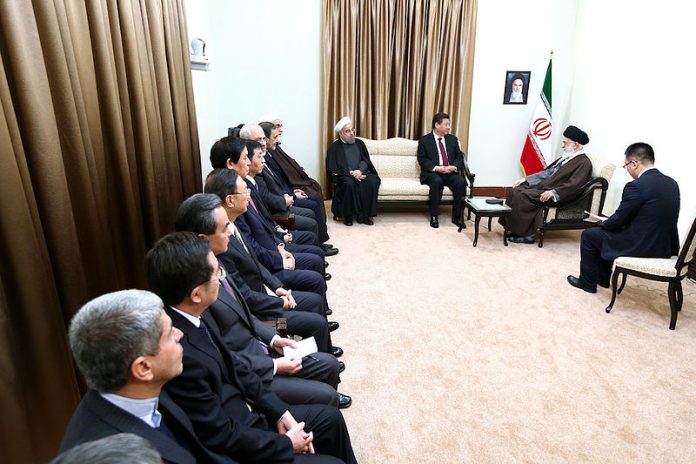The New York Times reported that it obtained information last July 2020 that Iran and China have forged a “25-year comprehensive partnership” that would develop Iran’s infrastructure and communications and satisfy China’s demand for oil and networks to complete its ambitious Belt and Road Initiative (BRI) in 2013. This development did not happen overnight as it was a byproduct of the 2016 meeting between Chinese President Xi Jinping and Iranian President Hassan Rouhani.
Several observers have a different take on this. Some view that this partnership officially made Iran a Chinese client state, while some did not. Others view that ambiguity in the actual commitments offer limits of what it can achieve. Nonetheless, the point stands: it would be a concern for states in the Indo-Pacific as China found a partner to fuel its regional ambitions in the region.
However, an overstatement of the threat is premature. In an uncertain world where states can hurt each other, states would have to be rational actors by calculating the costs and benefits of every action to maximize one’s relative power over another. With this, the Iran-China axis is a gamble if it continues. The cost of this alliance bears much weight for Iran’s interests. In this regard, states in the Indo-Pacific can be less concerned about the alliance’s net power.
After the U.S. President Donald Trump withdrew from the Iran Nuclear Deal, narratives flow that it left Iran with no choice but to gravitate towards China. As China continues to build its ambitions through the Belt and Road Initiative (BRI) since 2013, it may be convenient to say that the China-Iran alliance is inevitable. The arrangement would raise some eyebrows, but the threat it poses in the coming decades of the 21st Century would not be high.
Many states in the Indo-Pacific have started gravitating towards American leadership to withstand the Chinese threat because of their shared woes in their backyard. The Quadrilateral Security Dialogue (Quad) has finally become more robust compared to previous years through intensified naval and intelligence-exchanges. The Association of the Southeast Asian Nations (ASEAN) also shunned Chinese revisionism in the South China Sea and upheld the ASEAN Outlook on the Indo-Pacific. In this regard, Sino-American competition in the Indo-Pacific is likely to increase even after the COVID-19 pandemic.
The assassination of Iranian General Qassem Soleimani mounted contentions as well that this would bring a dilemma to China as it tries to carve a peaceful path to realize its BRI. But given the situation, China’s partnership with Iran cements that Beijing pushes back against American-led coalitions. Iran would not want to become more isolated from the rest of the world, given the pains of U.S. economic sanctions and the shock brought by the COVID-19 pandemic.
As far as threat assessment is concerned, American allies and partners in the region may have stakes preventing Sino-Persian alliance, but Iran can have more concerns with the backfire. The pandemic was not an excuse for Chinese President Xi Jinping not to fulfill the Chinese Dream. Instead, China reacted to several criticisms brought against it due to its mishandling of the COVID-19 pandemic.
With the Quad becomes more solid in their resolve, deterrence by punishment to China becomes more likely. If this happens, Iran would need to enter the reconsideration stage to conduct damage control from being dragged into conflict against China – a worst-case scenario for the state with an ailing economy.
Japan has large stakes in Iran due to dependence on oil imports, with about 499 thousand barrels per day. However, the cost of Tokyo’s oil dependence is lesser than the security alliance with the U.S. because of the Chinese threat, specifically in the disputed Diaoyu/Senkaku islands. In this regard, Japan would like to keep Iran tamed if possible. In March 2019, Japanese companies halted Iranian oil imports due to the expiration of a temporary waiver on American sanctions targeting Tehran’s nuclear program. Moreover, Japan intended to send its navy in the Persian Gulf to protect its commercial vessels — a slap to Iran that it has poor potential for regional leadership in the oil-rich region.
If China-Iran alliance intensifies, Japan would perceive it as expediting China’s relative power over its own. Japan’s bad option than worse would seem to continue aligning with the U.S.-led initiative. The Iran-China alliance would have a poor threat level against the U.S.-led coalition.
India may likely experience a difficult strategic choice about the Iran-China axis. Accordingly, India has a significant interest in the Chabahar seaport in Iran since it is a major investor that develops it. For India, the port is important since it allows them market access to landlocked Afghanistan, bypassing Pakistan. Notably, the said port was the only place in Iran that was never sanctioned by the U.S., and it may be rational for Tehran to maintain relations with New Delhi to avoid the withdrawal of Indian companies.
However, if Iran chooses to deepen its ties with China, it would have to face the cost of Indian companies’ possible withdrawal from the Chabahar project. Iran can never lever something as valuable as the Chabahar port again.
Australia has refocused its “immediate region” – the Indo-Pacific – to contain Chinese revisionism of the rules-based order through its 2020 Defence Strategic Update. Effectively, Canberra reaffirms U.S. leadership in the region. An Iran-China alliance would not be delightful for Canberra’s elites – and neither Tehran’s. Iranian goods like wheat, wool, and meat are exported to Australia to diversify its oil-dependent economy, accounting for about $572 million in fiscal years of 2017-2018. Moreover, the Iran-China alliance would increase Australian presence in the Indian Ocean to counter China’s String of Pearls in the region. This scenario is likely as Australia would join the 2020 Malabar Exercise with other Quad states.
If Iran-China alliance persists, then Tehran would likely be dragged into a security competition it does not need in the wider Indian Ocean. Not to mention that its naval capability grows weaker by the day. It would also need to hurdle against unrelenting Australian elites amid tariffs that have already stood ground against the Chinese threat.
In a world where uncertainty is for certain, states need to be rational to weigh the costs and benefits to maximize their power. In this case, Iran’s gravitation towards China bears more costs than benefits. Iran cannot afford to take this hard beating as it battles the consequences of economic sanctions and the COVID-19 crisis. Not to mention that Iran can also suffer China’s debt-trap diplomacy in the future. Though ramifications of Chinese investments may occur for the post-pandemic scenario, Chinese regional ambition would go on and Iran would go full-blown suicide. But it is not the way states behave in the world. With that, pumping the Iran-China alliance would pose a threat only to themselves in the long-term.
The views and opinions expressed in this article are those of the author and do not necessarily reflect the official policy or position of The Geopolitics, the Armed Forces of the Philippines, the Philippine Government or any other organizations.

The author is a Manila-based defense analyst and international affairs academic who works and writes about issues and topics regarding the Great Power Politics of the Indo-Pacific, Philippine Strategic Culture, and ASEAN Studies. He currently pursues his master’s degree in International Studies at the University of the Philippines, Diliman.


